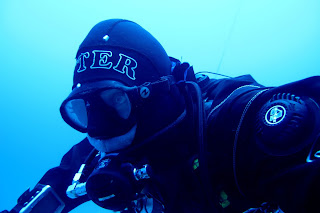This is a story very close to me that up to a year ago i was not 100% sure how bad a PFO is till one day my girl friend and me went to Gozo for day deep diving, following all the rules and doing nice profile dives between 30-40 meters only to find on our way back her skin started to break out in a rash,then migraines,to the point 2 hours later as we arrived back in Malta to rush straight to the chamber were she was decompressed for 12 hours, below is an article about what is and how serious it is for diving
A hole in your heart would seem
to be the very definition of a “problem.” Yet more than a quarter of the
population has one, and for most it causes no adverse health effects. In fact,
the vast majority of those affected don’t even know it. There are two kinds of
holes in the heart. One is called an atrial septal defect (ASD), and the other
is a patent foramen ovale (PFO). Although both are holes in the wall of tissue
(septum) between the left and right upper chambers of the heart (atria), their
causes are quite different. An ASD is a failure of the septal tissue to form
between the atria, and as such it is considered a congenital heart defect,
something that you are born with. Generally an ASD hole is larger than that of
a PFO. The larger the hole, the more likely there are to be symptoms.
PFOs, on the other hand, can only
occur after birth when the foramen ovale fails to close. The foramen ovale is a
hole in the wall between the left and right atria of every human fetus. This
hole allows blood to bypass the fetal lungs, which cannot work until they are
exposed to air. When a newborn enters the world and takes its first breath, the
foramen ovale closes, and within a few months it has sealed completely in about
75 percent of us. When it remains open, it is called a patent foramen ovale,
patent meaning open. For the vast majority of the millions of people with a
PFO, it is not a problem, even though blood is leaking from the right atrium to
the left. Problems can arise when that blood contains a blood clot.
This incomplete seal is what is
termed patent foramen ovale, although it remains closed because of the pressure
differential between the two atria. (Patent is Latin for open, indicating the
incompleteness of the seal.) In rare instances, the foramen ovale remains
completely open - this condition is more pronounced and is called atrial septal
defect. Why should the presence of patent foramen ovale be important? It isn't
to a nondiver. People with patent foramen ovale are completely unaware of it
and will go through life completely free of any symptoms related to it. For a diver,
it is important. The reason is that some divers, depending on depth and
duration of their dives, produce bubbles in their venous blood during and after
decompression (ascent from the dive). These bubbles are small, usually
relatively few in number, and do not give rise to any symptoms since they are
trapped by the small blood vessels in the lungs and filtered out of the
circulation.
Recent evidence shows that after
decompression, many normal scuba dives, with no symptoms of decompression
sickness, may produce bubbles in the venous blood. Why is this important for a
diver with patent foramen ovale? It has been found that some people with patent
foramen ovale may actually pump leak quantities of blood from the right atrium
to the left atrium. This suggests that divers who have patent foramen ovale who
also have venous gas bubbles during decompression may pass gas bubbles directly
into the left atrium, bypassing the lungs. Gas bubbles in the left atrium are
then carried to the body tissues, where they cause symptoms which all different
from migraine’s,loss of sight, fatigue, dizziness ect .
Can it be fixed? Yes can all PFO
be repaired? No.
A catheter can also be used to
guide the placement of a patent foramen ovale closure device - which becomes a
permanent implant - that will close the hole (prevent the flaps from opening)
in the heart wall. The catheter is initially inserted into a large vein through
a small incision made usually in the inner thigh (groin area). The catheter is
slowly moved into the heart and the PFO closure device is moved through the
catheter to the heart and specifically to the location of the heart wall
defect. Once in the correct location,
the PFO closure device is allowed to expand its shape to straddle each side of
the hole. The device will remain in the heart permanently to stop the abnormal
flow of blood between the two atria chambers of the heart. The catheter is then
removed and the procedure is complete. The cardiac catheterization procedure
for a PFO closure typically takes 2 to 4 hours to complete. A local anesthetic
is used to numb the groin area where the catheter was inserted. Use of general
anesthesia or sedation by IV is situation dependent — depending on doctor
preference and particular patient needs.
Depending on the size of the PFO
and location if it can be fixed as not all are repairable.
She has had her PFO closed and has done a number of medical test to make sure its safe for her to start diving and has been given the ok to start diving, but how will this effect her, well now she has to start from shallow dives max 4-5 meters and on high oxygen blends or commonly known as Nitrox to divers, and long safety stops running on Air tables for extra safety margins.
















